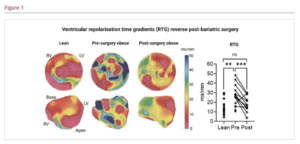Introduction: Obesity confers higher risks of cardiac arrhythmias and sudden cardiac death. Given that early bariatric surgery reverses and prevents some metabolic complications of obesity, the same may also be true for the risk of cardiac arrhythmias. However, the evidence for weight loss mitigating arrhythmic risk is conflicting and inconclusive. We therefore used electrocardiographic imaging (ECGi) to provide non-invasive characterisation of the proarrhythmic substrate in obese patients before and after bariatric surgery.
Methods: A total of 16 obese patients (43 ± 12 years, 13 female) underwent ECGi before bariatric surgery (PreSurg), of whom 12 had ECGi post-surgery (PostSurg). In addition, 16 age- and sex-matched lean individuals (42 ± 11 years, 13 females) underwent the same protocol. All participants were in sinus rhythm, had no history of cardiac arrhythmias and were not prescribed QT-prolonging medication. ECGi comprised body surface mapping with 256 electrodes and magnetic resonance imaging. Unipolar atrial and ventricular epicardial electrograms were computed by solving the inverse problem of electrocardiography to calculate local atrial and ventricular activation (AT) and ventricular repolarisation (RT) times. Activation and repolarisation heterogeneity was quantified by their respective gradients. These were calculated as their respective maximum differences between two electrograms within a 10 mm radius divided by their anatomical distance.
Results: Bariatric surgery led to a significant reduction in body mass index (46.7 ± 5.5 kg/m2 vs 36.8 ± 6.5 kg/m2; p<0.001), which was greater than in lean individuals (22.8 ± 2.6 kg/m2). This was accompanied by a reduction in epicardial adipose tissue (EAT) volume (83 ± 56 cm3 vs 69 ± 45 cm3; p=0.001). Total atrial activation time was prolonged in PreSurg vs lean, and remained prolonged in PostSurg (62 ± 15 vs 46 ± 12 vs 67 ± 15 ms). Atrial activation gradients were also greater in PreSurg vs lean and were not improved in PostSurg (26 ± 11 vs 14 ± 8 vs 25 ± 12 ms). Ventricular repolarisation gradients were greater in PreSurg vs lean (26 ± 11 vs 15 ± 7 ms/mm; p=0.0024), which was reversed in PostSurg (19 ± 8 ms/mm; p=0.0009 vs PreSurg) (Figure). EAT volumes correlated with atrial activation and ventricular repolarisation gradients (r=0.36, p=0.044 and r=0.54, p=0.0014, respectively).
Conclusion: Compared with lean individuals, obesity is associated with subclinical electrophysiological remodelling, even in patients without a history of arrhythmias. This includes atrial activation prolongation and steeper ventricular repolarisation gradients. Bariatric surgery led to regression of EAT, as well as reversal of steep ventricular repolarisation gradients but did not improve atrial activation. Our data suggest that early surgical weight reduction in obese patients without cardiac arrhythmias can partly reverse the pro-arrhythmic remodelling to reduce the risks of developing arrhythmias. ❑








